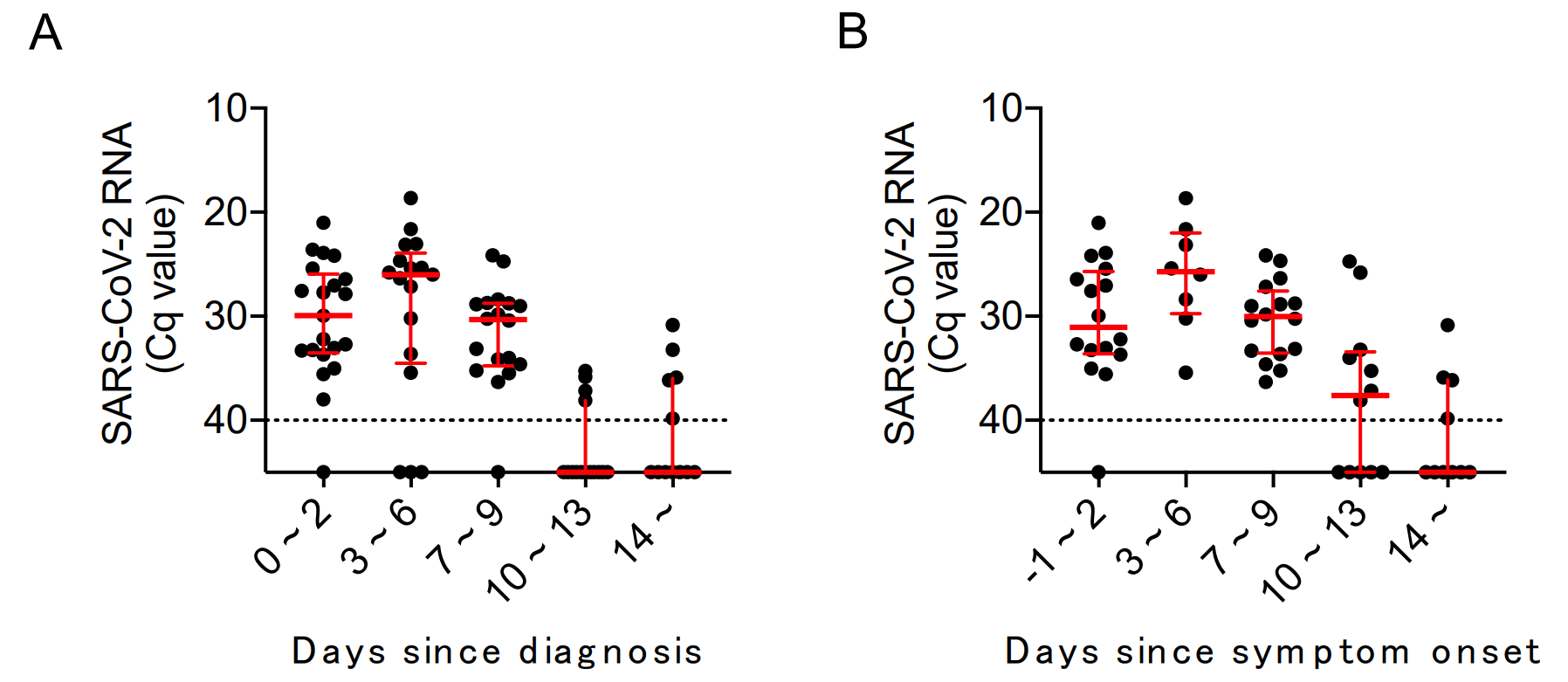January 5, 2022
Active epidemiological investigation on SARS-CoV-2 infection caused by Omicron variant (Pango lineage B.1.1.529) in Japan: preliminary report on infectious period
National Institute of Infectious Diseases Disease Control and Prevention Center, National Center for Global Health and Medicine
Coronavirus disease 2019 (COVID-19), caused by severe acute respiratory syndrome coronavirus 2 (SARS-CoV-2), continues to cause significant morbidity and mortality globally. Since the first detection of a new SARS-CoV-2 variant belonging to the Pango lineage B.1.1.529 (Omicron variant), it has been spreading rapidly around the world. The World Health Organization classified the SARS-CoV-2 variant belonging to B.1.1.529 as a Variant of Concern (VOC) due to possible changes in viral characteristics. The Omicron variant contains a larger number of mutations in its spike protein, resulting in substantial changes in its infectivity, transmissibility and/or immune evasion capabilities and raising a serious public health concern globally.
In Japan, individuals infected with SARS-CoV-2 are hospitalized in accordance with the Infectious Diseases Control Law or the Quarantine Act. Since the evidence is lacking on the Omicron variant, individuals infected with the Omicron variant (Omicron cases) have different discharge criteria from those infected with non-Omicron variants of SARS-CoV-2 (non-Omicron cases) after November 30, 2021 in Japan. According to the criteria for discharge of Omicron cases as of January 5, 2022, they are released from medical facilities after two consecutive negative tests by nucleic acid amplification or antigen quantification methods. However, there is a concern that these discharge criteria may lead to prolonged hospitalization and increase the burden on cases, medical facilities, as well as public health centers/institutions. Therefore, it is necessary to examine the duration of virus shedding in Omicron cases in order to provide evidence to simplify the discharge criteria.
Since December 3, 2021, the National Institute of Infectious Diseases (NIID) and the Disease Control and Prevention Center within the National Center for Global Health and Medicine (NCGM/DCC) have jointly initiated an investigation on Omicron cases in collaboration with several medical facilities in Japan. Here, we examined the duration of infectious virus shedding in Omicron cases identified early in this investigation. A total of 83 respiratory specimens from 21 cases (19 vaccinees and 2 unvaccinated cases; 4 asymptomatic and 17 mild cases) were subjected to SARS-CoV-2 RNA quantification using quantitative reverse transcriptase polymerase chain reaction and virus isolation tests. The date of specimen collection for diagnosis or symptom onset was defined as day 0. The amount of viral RNA was highest on 3-6 days after diagnosis or 3-6 days after symptom onset, and then gradually decreased over time, with a marked decrease after 10 days since diagnosis or symptom onset (Figure). The positive virus isolation results showed a similar trend as the viral RNA amount, and no infectious virus in the respiratory samples was detected after 10 days since diagnosis or symptom onset (Table). These findings suggest that vaccinated Omicron cases are unlikely to shed infectious virus 10 days after diagnosis or symptom onset.
Acknowledgement
We thank the following medical facilities for their contribution in providing us with valuable patient information and samples: National Center for Global Health and Medicine, Rinku General Medical Center.
Figure. Kinetics of viral RNA amount in respiratory samples obtained from Omicron variant infected cases
(A and B) Quantitative reverse transcriptase polymerase chain reaction (RT-qPCR) done at NIID for all respiratory samples received using NIID-N2 primer/probe set for cases of SARS-CoV-2 Omicron variant infection. The levels of viral RNA by (A) days since diagnosis or (B) days since symptom onset. Red bars indicate median Cq value with interquartile range. Dotted line indicates a cutoff value.

(A) Number and percentage of viral RNA positive or virus isolation positive samples by days since diagnosis
|
Days since diagnosis |
Number and percentage of viral RNA positive samples n (%) |
Number and percentage of virus isolation positive samples n (%) |
Number and percentage of virus isolation positive in viral RNA positive samples n (%) |
|
0 ~ 2 days |
20/21 (95.2) |
2/21 (9.5) |
2/20 (10.0) |
|
3 ~ 6 days |
14/17 (82.4) |
7/17 (41.2) |
7/14 (50.0) |
|
7 ~ 9 days |
17/18 (94.4) |
2/18 (11.1) |
2/17 (11.8) |
|
10 ~ 13 days |
4/15 (26.7) |
0/15 (0) |
0/4 (0) |
|
After 14 days |
5/12 (41.7) |
0/12 (0) |
0/5 (0) |
(B) Number and percentage of viral RNA positive or virus isolation positive samples by days since symptom onset (symptomatic cases only)
|
Days since symptom onset |
Number and percentage of viral RNA positive samples n (%) |
Number and percentage of virus isolation positive samples n (%) |
Number and percentage of virus isolation positive in viral RNA positive samples n (%) |
|
-1 ~ 2 days |
15/16 (93.8) |
2/16 (12.5) |
2/15 (13.3) |
|
3 ~ 6 days |
8/8 (100) |
4/8 (50.0) |
4/8 (50.0) |
|
7 ~ 9 days |
16/16 (100) |
3/16 (18.8) |
3/16 (18.8) |
|
10 ~ 13 days |
7/12 (58.3) |
0/12 (0) |
0/7 (0) |
|
After 14 days |
4/10 (40.0) |
0/10 (0) |
0/4 (0) |
(C) Number and percentage of viral RNA positive or virus isolation positive samples by days since diagnosis (asymptomatic cases only)
|
Days since positive test |
Number and percentage of viral RNA positive samples n (%) |
Number and percentage of virus isolation positive samples n (%) |
Number and percentage of virus isolation positive in viral RNA positive samples n (%) |
|
0 ~ 5 days |
6/6 (100) |
3/6 (50.0) |
3/6 (50.0) |
|
6 ~ 9 days |
3/4 (75.0) |
0/4 (0) |
0/3 (0) |
|
After 10 days |
1/10 (10) |
0/10 (0) |
0/1 (0) |